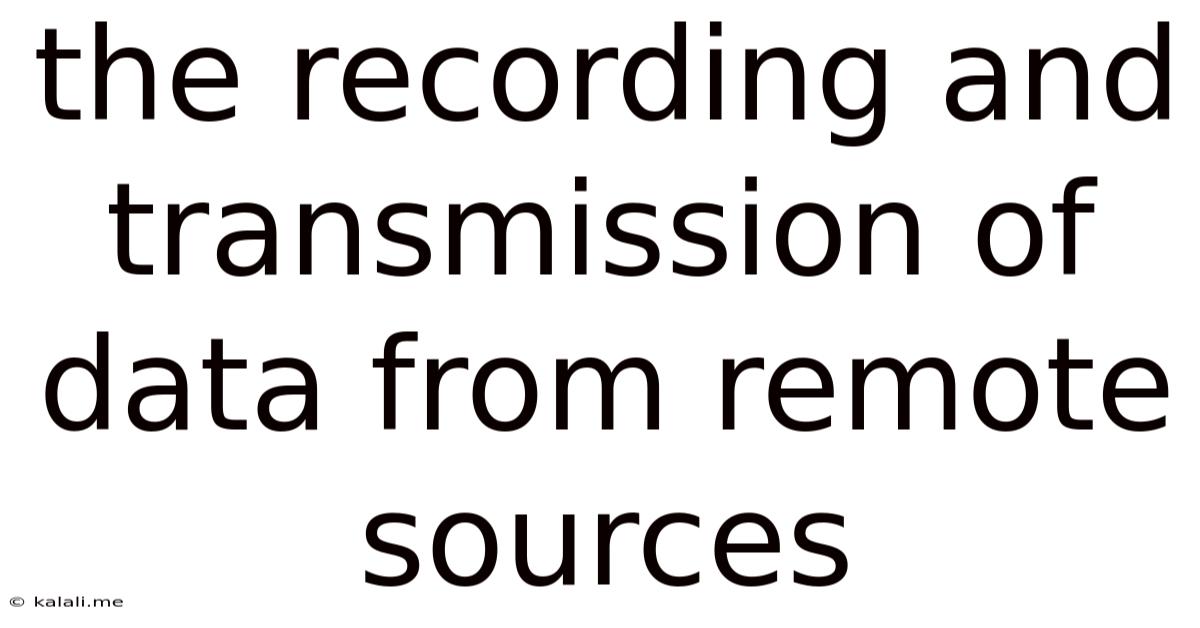The Recording And Transmission Of Data From Remote Sources
Kalali
Jun 11, 2025 · 3 min read

Table of Contents
The Recording and Transmission of Data from Remote Sources: A Comprehensive Guide
Meta Description: Learn how to effectively record and transmit data from remote sources, covering hardware, software, communication protocols, and security best practices for reliable data acquisition.
The ability to record and transmit data from remote sources is crucial across a vast range of applications, from environmental monitoring and industrial automation to healthcare and scientific research. This process, however, requires careful consideration of several interconnected factors, from the initial data acquisition to its secure transmission and subsequent analysis. This comprehensive guide will delve into the key aspects of this process.
Hardware Considerations for Remote Data Acquisition
The first step involves selecting the appropriate hardware for data acquisition. This depends heavily on the type of data being collected and the environment. Key components include:
- Sensors: These are the frontline devices responsible for converting physical phenomena (temperature, pressure, light, etc.) into measurable electrical signals. Choosing the right sensor is paramount; accuracy, precision, and environmental robustness are critical considerations. Consider factors like sensor range, resolution, and power consumption.
- Data Loggers: These devices record the sensor readings, often storing them locally until transmission. Features to consider include storage capacity, sampling rate, battery life, and communication interfaces. Some loggers offer onboard processing capabilities, allowing for preliminary data manipulation before transmission.
- Communication Modules: These modules enable data transmission from the remote location. Popular options include cellular (3G/4G/5G), satellite, Wi-Fi, and low-power wide-area networks (LPWANs) like LoRaWAN or Sigfox. The choice depends on factors such as availability, cost, power consumption, and data transmission rate.
- Power Supply: A reliable power source is essential, especially in remote locations. Options include batteries (with solar charging capabilities), mains power (if available), or fuel cells. Consider the power requirements of all connected devices and plan for backup power in case of outages.
Software and Communication Protocols
Effective data transmission requires a robust software infrastructure. This typically involves:
- Data Acquisition Software: This software interacts with the data logger, collecting and formatting the raw sensor data. Features often include real-time data visualization, data logging, and alarm triggers.
- Communication Protocols: Various protocols govern the transmission of data. Common options include MQTT (Message Queuing Telemetry Transport), HTTP, and AMQP (Advanced Message Queuing Protocol). The choice depends on the network infrastructure, required data throughput, and desired level of reliability. MQTT is often preferred for its lightweight nature and suitability for resource-constrained devices.
- Cloud Platforms: Cloud platforms (AWS, Azure, Google Cloud) offer scalable and secure solutions for data storage, processing, and analysis. They frequently integrate well with various communication protocols, simplifying data management.
Data Security and Reliability
Data security and reliability are paramount. Consider these best practices:
- Encryption: Encrypting data both in transit and at rest is essential to protect sensitive information from unauthorized access. Employ strong encryption algorithms like AES (Advanced Encryption Standard).
- Authentication and Authorization: Implement robust mechanisms to authenticate devices and users, ensuring only authorized entities can access and modify data.
- Data Validation and Error Handling: Implement measures to detect and handle data errors, ensuring the integrity and accuracy of the collected data. This might involve checksums or error-correcting codes.
- Redundancy and Failover: Design the system with redundancy to mitigate the impact of hardware or network failures. This could involve using multiple sensors, communication pathways, or data storage locations.
Conclusion
Recording and transmitting data from remote sources presents unique challenges, demanding careful planning and execution. By carefully considering hardware choices, software design, communication protocols, and security best practices, you can build a robust and reliable system capable of delivering valuable insights from even the most challenging environments. Remember to tailor your solution to the specific requirements of your application, prioritizing reliability, security, and scalability.
Latest Posts
Latest Posts
-
How Many Apples In A 3 Pound Bag
Jul 01, 2025
-
How Many Pounds Is A Bushel Of Peanuts
Jul 01, 2025
-
How Many Pounds Are In 32 Ounces
Jul 01, 2025
-
What Year Would I Be Born If I Was 21
Jul 01, 2025
-
How Many Minutes Are In 40 Hours
Jul 01, 2025
Related Post
Thank you for visiting our website which covers about The Recording And Transmission Of Data From Remote Sources . We hope the information provided has been useful to you. Feel free to contact us if you have any questions or need further assistance. See you next time and don't miss to bookmark.